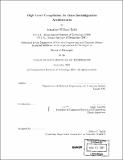| dc.contributor.advisor | Anant Agarwal. | en_US |
| dc.contributor.author | Babb, Jonathan William | en_US |
| dc.contributor.other | Massachusetts Institute of Technology. Dept. of Electrical Engineering and Computer Science. | en_US |
| dc.date.accessioned | 2005-08-23T18:22:47Z | |
| dc.date.available | 2005-08-23T18:22:47Z | |
| dc.date.copyright | 2001 | en_US |
| dc.date.issued | 2001 | en_US |
| dc.identifier.uri | http://hdl.handle.net/1721.1/8217 | |
| dc.description | Thesis (Ph. D.)--Massachusetts Institute of Technology, Dept. of Electrical Engineering and Computer Science, 2001. | en_US |
| dc.description | Includes bibliographical references (p. 205-215). | en_US |
| dc.description.abstract | A continuing exponential increase in the number of programmable elements is turning management of gate-reconfigurable architectures as "glue logic" into an intractable problem; it is past time to raise this abstraction level. The physical hardware in gate-reconfigurable architectures is all low level - individual wires, bit-level functions, and single bit registers - hence one should look to the fetch-decode-execute machinery of traditional computers for higher level abstractions. Ordinary computers have machine-level architectural mechanisms that interpret instructions - instructions that are generated by a high-level compiler. Efficiently moving up to the next abstraction level requires leveraging these mechanisms without introducing the overhead of machine-level interpretation. In this dissertation, I solve this fundamental problem by specializing architectural mechanisms with respect to input programs. This solution is the key to efficient compilation of high-level programs to gate reconfigurable architectures. My approach to specialization includes several novel techniques. I develop, with others, extensive bitwidth analyses that apply to registers, pointers, and arrays. I use pointer analysis and memory disambiguation to target devices with blocks of embedded memory. My approach to memory parallelization generates a spatial hierarchy that enables easier-to-synthesize logic state machines with smaller circuits and no long wires. | en_US |
| dc.description.abstract | (cont.) My space-time scheduling approach integrates the techniques of high-level synthesis with the static routing concepts developed for single-chip multiprocessors. Using DeepC, a prototype compiler demonstrating my thesis, I compile a new benchmark suite to Xilinx Virtex FPGAs. Resulting performance is comparable to a custom MIPS processor, with smaller area (40 percent on average), higher evaluation speeds (2.4x), and lower energy (18x) and energy-delay (45x). Specialization of advanced mechanisms results in additional speedup, scaling with hardware area, at the expense of power. For comparison, I also target IBM's standard cell SA-27E process and the RAW microprocessor. Results include sensitivity analysis to the different mechanisms specialized and a grand comparison between alternate targets. | en_US |
| dc.description.statementofresponsibility | by Jonathan William Babb. | en_US |
| dc.format.extent | 215 p. | en_US |
| dc.format.extent | 25243118 bytes | |
| dc.format.extent | 25242875 bytes | |
| dc.format.mimetype | application/pdf | |
| dc.format.mimetype | application/pdf | |
| dc.language.iso | eng | en_US |
| dc.publisher | Massachusetts Institute of Technology | en_US |
| dc.rights | M.I.T. theses are protected by copyright. They may be viewed from this source for any purpose, but reproduction or distribution in any format is prohibited without written permission. See provided URL for inquiries about permission. | en_US |
| dc.rights.uri | http://dspace.mit.edu/handle/1721.1/7582 | |
| dc.subject | Electrical Engineering and Computer Science. | en_US |
| dc.title | High level compilation for gate reconfigurable architectures | en_US |
| dc.type | Thesis | en_US |
| dc.description.degree | Ph.D. | en_US |
| dc.contributor.department | Massachusetts Institute of Technology. Department of Electrical Engineering and Computer Science | |
| dc.identifier.oclc | 50139788 | en_US |

